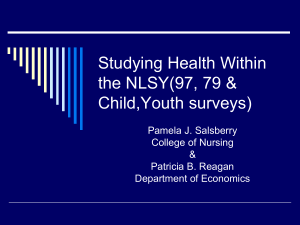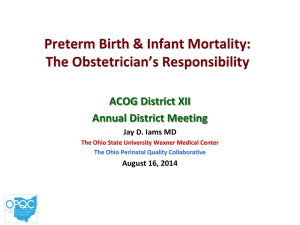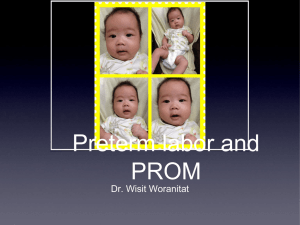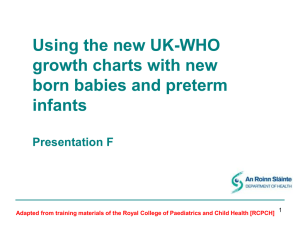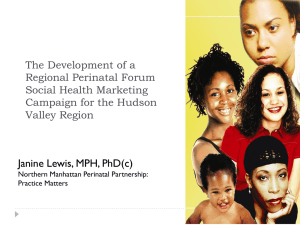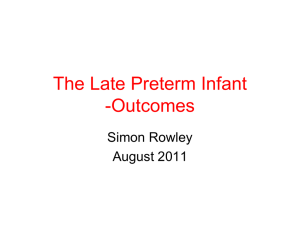U. parvum
advertisement
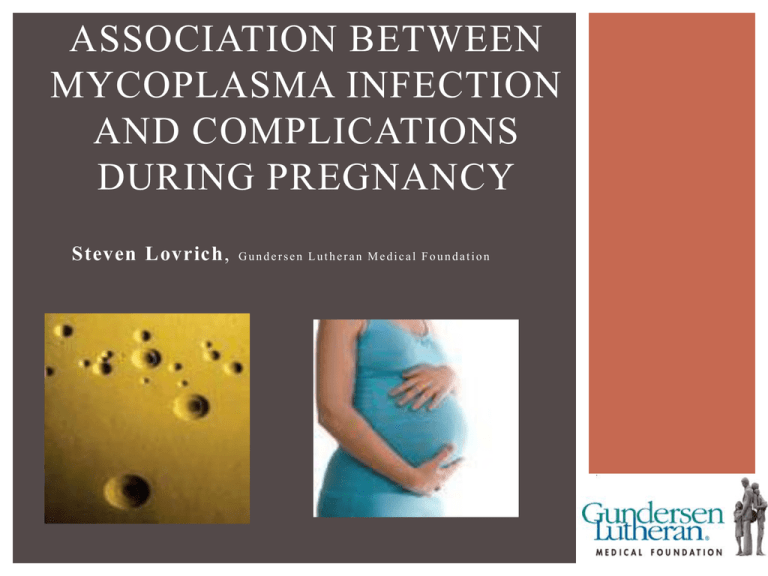
ASSOCIATION BETWEEN MYCOPLASMA INFECTION AND COMPLICATIONS DURING PREGNANCY Steven Lovrich, Gundersen Lutheran Medical Foundation MYCOPLASMA Mollicutes: “soft skin” Intracellular parasite Lack cell wall Trilayered external membranes 2 genera: Mycoplasma 14 human species; three pathogenic M. hominis M. genitalium M. pneumoniae Ureaplasma Microscopic view of Mycoplamsas 2 human species; both pathogenic U. urealyticum U. parvum (Taylor-Robinson et al., An International Journal of Obstetrics and Gynecology, 2010) LABORATORY CHARACTERISTICS Facultative anaerobes Pleomorphic Limited genome Unable to gram stain Culture? (Larsen et al., Infectious Diseases in Obstetrics and Gynecology, 2010) VIRULENCE Normal Flora/Non-pathogenic colonizers? Pathogenic? Opportunistic pathogen Location of colonization Host immune response Conditions of pregnancy Co-infections Genetic factors Environmental factors PATHOGENICITY DURING PREGNANCY Adherence to host cell by mycoplasmal adhesion proteins/lipoproteins Stimulate secretion of pro -inflammatory cytokines (tumor necrosis factor- , interleukin, & interferon -γ) Stimulate release of prostaglandins which leads to protease production Protease can cause adverse pregnancy outcomes miscarriage, pre-term labor, bacterial vaginosis, chorioamnionitis, spontaneous abortion, perinatal morbidity & mortality, PROM, etc. PRE-TERM BIRTH Problems: Genital tract infections associated with approximately 50% of preterm deliveries 13% of pregnancies in the U.S. result in preterm delivery or low infant birth weight 60% of mortality among infants (with no anatomic/chromosomal defects) is low birth weight ( K a t a o ka , J o u r n a l o f C l i n i c a l M i c r o b i o l o gy, 2 0 0 6 ) , ( Ta yl o r - R o b i n s o n , An I n t e r n a t i o n a l J o u r n a l o f O b s t e t r i c s a n d Gyn e c o l o g y, 2010) MYCOPLASMA HOMINIS Strongly associated with: Chorioamnionitis Pelvic inflammatory disease Bacterial vaginosis Pregnancy Mycoplasma hominis on agar plate Lower gestational age at delivery Lower birth weight Increased neonatal morbidity & mortality Increase risk for miscarriage at 14 weeks Infant Pneumonia MYCOPLASMA GENITALIUM Causative agent of urethritis Associated with cervicitis, PID, and endometritis in women Pregnancy- Unknown Electron micrograph of M. genitalium ( Ta yl o r - R o b i n s o n , An I n t e r n a t i o n a l J o u r n a l o f O b s t e t r i c s a n d Gyn e c o l o g y, 2 0 1 0 ) UREAPLASMA SPP. In 2002, U. urealyticum & U. parvum distinguished as separate species Therefore, studies pre-2002 confounded UREAPLASMA UREALYTICUM Colonization of placenta= increases risk for fetal & maternal inflammation Increase risk of preterm labor Increase risk for miscarriage (@14 weeks) Vertically transmitted to fetus potentially causing: Bacteremia Pneumonia Chronic lung disease Nervous system infections Electron micrograph of U. urealyticum UREAPLASMA PARVUM Vertically transmitted to fetus in utero or during delivery Bacteremia, pneumonia, chronic lung disease, & nervous system infections More prevalent in amniotic fluid of preterm pregnancies than U. urealyticum If colonization occurs can cause: Electron micrograph of U. parvum PROM Preterm labor Chorioamnionitis (in mother) Early onset sepsis & BPD (bronchopulmonary dysplasia) in baby ( La r s e n e t a l . , I n fe c t i o u s D i s e a s e s i n O b s t e t r i c s a n d Gyn e c o l o g y, 2 0 1 0 ) ASSOCIATION OF UREAPLASMA WITH PRETERM BIRTH Objectives: 1. Determine if colonization of either Ureaplasma species had association with miscarriage or preterm labor 2. To perfect detection methods and discrimination of species Methods: Tested 239 pregnant women (PCR) from the La Crosse area for colonization with Ureaplasma urealyticum & parvum during early prenatal period SUMMARY OF RESULTS 239 patient samples at start 192 follow ups at Gundersen Lutheran 47 lost 27 adverse events 23 preterm birth (≤36 weeks) or miscarriage 4 preterm labor (stopped) Significance of Colonization P-value ≤ 0.05 RESULTS Bacterial characteristics and cause of early delivery for the preterm birth group. Subject 1 2 3 4 5 6 7 8 9 10 11 12 13 14 15 16 17 18 19 20 21 22 23 a Gestational wk at delivery 6 9 18 26 30 31 34 35 35 35 35 35 36 36 36 36 36 36 36 36 36 36 36 Presence (+/-) of: U. parvum U. urealyticum + + + + + + + + + + + + + + + + + + + + - Cause of preterm deliverya Miscarriage Miscarriage Miscarriage PROM Preeclampsia PROM FSUA Preeclampsia Preeclampsia FSUA FSUA FSUA FSUA FSUA FSUA FSUA FSUA FSUA FGR Preeclampsia Preeclampsia FSUA FSUA PROM, premature rupture of the membranes; FSUA, failure to suppress uterine activity; FGR, fetal growth restriction. RESULTS Table 2. Association between urogenital infection with ureaplasmas and miscarriage, preterm labor controlled by treatment, and/or preterm birth. Pregnancy outcome (no.) No. (%) U. urealyticum p value No. (%) U. parvum p value Normal (165) 16 (10) NA 84 (51) NA Abnormal (27) 2 (7) 0.999 22 (81) 0.003 Miscarriage (3) 0 0.999 Preterm birth (20) 2 (10) 0.999 Preterm labor (4) 0 0.999 3 (100) 15 (75) 4 (100) •27 abnormal pregnancy outcomes -25 associated with U. parvum •U. parvum strongly associated with their occurrence (p=0.003) 0.245 0.057 0.122 CURRENT STUDY Previous study Small population sample Little diversity & limited risk factors Parameters: Project collaboration with WiNHR ( Wi s cons in N et w o r k f o r H eal t h care Res ear ch) 4 different hospital sites: 200 samples per site Aurora Health, Gundersen Lutheran, UW-Hospital (Madison), Marshfield Cinic Test for 4 Mycoplasma species * Objective: To determine if any of the 4 Mycoplasma species correlate with pregnancy abnormalities or adverse outcomes Examine multiple risk factors EXPERIMENTAL DESIGN Normal healthy pregnant women targeted in 4 sites across Wisconsin Swabs of urogenital tract (~12 weeks) Samples blinded DNA extracted and forwarded to Gundersen Lutheran Polymerase Chain Reaction (PCR) Hybridization assay HYBRIDIZATION ASSAY Biotinylated amplification product Aminated probe (4 species specific probes used) HYBRIDIZATION ASSAY Biotinylated amplification product Aminated probe (4 species specific probes used) HYBRIDIZATION ASSAY E Strepavidin-HPO conjugate Biotinylated amplification product Aminated probe (4 species specific probes used) HYBRIDIZATION ASSAY Substrate E(S) Strepavidin-HPO conjugate Biotinylated amplification product Aminated probe (4 species specific probes used) STUDY PROGRESS PCR hybridization assay completed on samples Correlations between species and adverse pregnancy outcomes ACKNOWLEDGEMENTS Thanks to: Microbiology Research Laboratory Gundersen Lutheran Medical Foundation Dr. Steve Callister Dean Jobe


